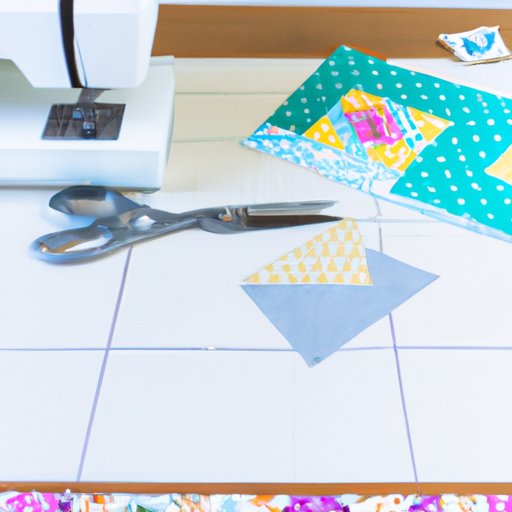Introduction
Quilting is an enjoyable and therapeutic hobby that involves piecing together layers of fabric to create beautiful designs. It’s a great way to express yourself creatively while also creating something useful and lasting. Quilting has a long history, with quilts made by hand dating back centuries. Today, quilting is still popular among all ages and skill levels, and there are countless resources available to help you get started.
In addition to its creative benefits, quilting offers a range of health benefits. According to a study published in the journal Arts & Health, quilting can reduce stress, anxiety, and depression, as well as promote relaxation and self-expression. The repetitive motions involved in quilting can also help to improve motor skills, coordination, and balance. For these reasons, quilting is a great way to relax and stay productive at the same time.
Research Quilting Materials and Tools
The first step in starting quilting is to research the materials and tools you’ll need. You may already have some of the basics such as scissors and measuring tape, but you will also need to invest in some quilting-specific items. Common quilting supplies include fabric, batting, thread, needles, a rotary cutter, and a cutting mat.
It’s important to invest in quality materials and tools, as they will last longer and make the quilting process easier. Research the best brands and compare prices to find the most cost-effective options. You should also consider purchasing second-hand items if you’re on a budget.
Attend a Quilting Class to Learn the Basics
Once you’ve gathered the supplies you need, the next step is to learn the basics of quilting. There are many ways to do this, including attending a local quilting class or taking an online course. Attending a class can be beneficial because it allows you to ask questions and receive feedback from an experienced instructor.
In a quilting class, you’ll typically learn about the different types of fabrics and tools used in quilting, as well as basic quilting stitches such as straight line, crosshatch, and patchwork. You’ll also learn how to measure and cut fabric, as well as how to assemble and finish a quilt.

Select a Quilt Pattern or Design
Once you’ve learned the basics of quilting, it’s time to choose a quilt pattern or design. There are many pre-made quilt patterns available, or you can design your own. When selecting a pattern, consider the size and complexity of the quilt, as well as the amount of time you have to complete it. If you’re just getting started, it’s best to choose a simple design and save more complex projects for later.

Choose the Right Fabric for Your Quilt
Choosing the right fabric for your quilt is an important step in the quilting process. There are many types of fabric available, including cotton, wool, and linen. Consider the weight and texture of the fabric when selecting it, as well as the colors and patterns. Make sure to choose fabrics that complement each other and the quilt pattern.
Learn Basic Quilting Techniques
Once you’ve chosen the fabric for your quilt, it’s time to learn the basic quilting techniques. These include stitching, binding, and quilting. To practice these techniques, start with scraps of fabric and practice on them before moving on to the actual project. This will help you become familiar with the techniques before tackling a larger quilt.

Assemble the Quilt Top and Backing
After you’ve practiced the basic quilting techniques, it’s time to assemble the quilt top and backing. Lay out the pieces of fabric and pin them together. Sew the pieces together using a sewing machine or by hand. Once the quilt top and backing are sewn together, it’s time to add the batting and quilt the entire project.
Conclusion
Starting quilting doesn’t have to be intimidating. With the right materials and tools, as well as some patience and practice, anyone can learn how to quilt. Get started by researching quilting materials and tools, attending a quilting class to learn the basics, selecting a quilt pattern or design, choosing the right fabric, and learning basic quilting techniques.
(Note: Is this article not meeting your expectations? Do you have knowledge or insights to share? Unlock new opportunities and expand your reach by joining our authors team. Click Registration to join us and share your expertise with our readers.)
